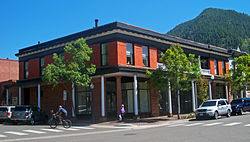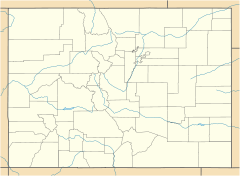- Collins Block
-
Collins Block – Aspen Lumber and Supply
 North and west elevations, 2010Location within Colorado
North and west elevations, 2010Location within ColoradoLocation: 204 S Mill St, Aspen, CO Coordinates: 39°11′22″N 106°49′9″W / 39.18944°N 106.81917°WCoordinates: 39°11′22″N 106°49′9″W / 39.18944°N 106.81917°W Built: 1891–93[2] Architectural style: Victorian, Neoclassical Governing body: Private businesses MPS: Aspen MRA NRHP Reference#: 87000191[1] Added to NRHP: March 6, 1987 The Collins Block is located at the intersection of East Hopkins Avenue and South Mill Street in Aspen, Colorado, United States. It is a brick and stone structure erected in the early 1890s. In 1987 it was listed on the National Register of Historic Places along with many other historic properties in the city.
It features classically inspired decorative touches unusual in the city, such as a colonnade-supported roof over the sidewalk and an elaborate cornice. For much of its existence it housed a lumber supply store. Local developer Harley Baldwin, owner of the neighboring Brand Building, bought it in 1988. After renovations, he began leasing space within the buildings to upscale retailers, earning the two the combined nickname of "Gucci Gulch". The Caribou Club, a members-only restaurant and Aspen institution, is located in the basement.
Contents
Building
The building is located on the southeast corner of the intersection. Other commercial structures, historic and modern, fill the built-out blocks. To the immediate east is the Brand Building, with Aspen City Hall on the opposite far corner. Both are listed on the Register. At the south end of the opposite block of Mill is another listed building, the Wheeler Opera House, opposite a pedestrian mall.
Like most of its neighbors (except the Wheeler), the Collins Block is two stories high. The north frontage, along East Hopkins, is five bays long with the western facade seven. Rusticated sandstone, interrupted by several storefronts and a recessed corner entrance with column, faces the first floor on both sides. A flat wooden roof extends out to cover the sidewalk on both sides, supported by smooth round wooden Tuscan columns.[2]
The second story is faced in brick. On the north face fenestration is one-over-one double-hung sash windows. Its middle three bays have a recessed porch with Ionic columns and a wooden balustrade.[2] At the roofline is a lightly dentilled cornice with broad overhanging eaves. The roof itself is flat.
Inside, the ground level consists of storefronts and offices. The upstairs level is a residence. In the basement is the Caribou Club.
Caribou Club
Entrance to the Caribou Club is via an unmarked mahogany door with brass trim. It opens into a paneled entry area with 19th-century Western landscape paintings. On the east is the entrance to the Great Room, similarly paneled in wood and British racing green. It is decorated with more landscapes, by Frederic Remington and Albert Bierstadt, among others. Its dominant piece of furniture is a 10-foot (3 m) sofa with an equally long ottoman.[3]
The main corridor leads around the Great Room past bathrooms, the wine cellar and two private rooms to the bar, also accessible from the Great Room.[4] The room has many personal pictures from members on its wall. The bar itself is mahogany with a brass rail along the floor.[3]
In the southeast corner is the dining room. It is finished in a shade described as "somewhere between Etruscan red and a ripe tomato." Light is furnished by candles and antler chandeliers. There are six round tables for diners.[3]
History
Built between 1891 and 1893, near the end of Aspen's early boom years,[2] the Collins survived into the city's "quiet years" of steady population decline, when vacancy and disuse felled many of the other relics of that era. In the 1930s, a time when Aspen was down to less than a thousand people, the Collins housed a mortuary. A couple named Tom and Alice Rachel Sardy bought it and moved in. They also became proprietors of another business in the building, Aspen Supply, which sold furniture and hardware.[5]
The mortuary was successful enough that the Sardy family was able to move out and build a house on Main Street across from Paepcke Park which is still known as the Sardy House. They bought a lumber business across the street, moved the mortuary to their house and combined the two businesses into Aspen Lumber & Supply, using almost the whole Collins Block. After World War II, Aspen began to develop into the ski resort town it is today. The Sardys sold part of both their family businesses to Walter Paepcke, the Chicago businessman who guided much of that era of the city's development. In the late 1940s, Tom Sardy recognized that Aspen would need a modern airport, and after being elected a Pitkin County commissioner worked to get one built. Sardy Field at Aspen-Pitkin County Airport is named in his honor.[5]
In 1988 the Collins was acquired by Aspen developer and businessman Harley Baldwin, who already owned the neighboring Brand Building. Returning to Aspen after 16 years of activity in New York, he undertook extensive renovations to the structure. The upper floor he returned to residential use, building for himself and his partner, Richard Edwards, a 6,000-square-foot (560 m2) penthouse that was later featured in Architectural Digest.[6]
On the ground level he eased out the remnants of the hardware store and other, similar retail tenants. In their place came upscale fashion boutiques such as Bulgari and Brioni, complementing the Louis Vuitton, Gucci and Dior presence at the other end of the block.[7] These entrants into the local marketplace, into a city that had not previously shown the effect of its growing population of rich and famous residents, earned the two buildings the nickname "Glitter Gulch", which eventually became applied to Aspen as a whole.[6]
In the basement of the Collins, Baldwin built the Caribou Club. Admission was limited to members only, the first time such an establishment had opened in Aspen, where celebrities and locals had previously mixed at the Hotel Jerome's bar. Baldwin was criticized for this,[8] but the Caribou became one of the city's most popular nightspots.[9] Diana Ross and Tom Ford, as well as businesspeople like Warren Lichtenstein and Lynda Resnick, are among the regulars.[7]
See also
References
- ^ "National Register Information System". National Register of Historic Places. National Park Service. 2009-03-13. http://nrhp.focus.nps.gov/natreg/docs/All_Data.html.
- ^ a b c d "Pitkin County". Colorado Office of Archaeology and Historic Preservation. http://www.historycolorado.org/oahp/pitkin-county. Retrieved March 10, 2011.
- ^ a b c "Welcome to the Caribou Club, Aspen, Colorado". The Caribou Club. http://www.caribouclub.com/letter_11.html. Retrieved April 22, 2011.
- ^ "Club Floor Plan". The Caribou Club. http://www.caribouclub.com/floorpl_11.html. Retrieved April 22, 2011.
- ^ a b Condon, Scott (March 17, 2010). "Alice Sardy, one of Aspen's 'sweetest' dies at age 101". Vail Daily (Vail, CO). http://www.vaildaily.com/article/20100317/NEWS/100319641. Retrieved April 22, 2010.
- ^ a b Oliver, Myrna (February 7, 2005). "Harley Baldwin, 59; Led Effort to Transform Aspen". Los Angeles Times. http://articles.latimes.com/2005/feb/07/local/me-baldwin7. Retrieved April 22, 2011.
- ^ a b Knadler, Jessie (December 16, 2006). "Caribou Club, Aspen, Colo.". The Wall Street Journal. http://online.wsj.com/article/SB116623696577052286.html. Retrieved April 22, 2011.
- ^ Urqhart, Janet (January 30, 2005). "Harley Baldwin, entrepreneurial 'force of nature'". Aspen Times. http://www.aspentimes.com/article/20050130/ASPENWEEKLY/101300008. Retrieved April 22, 2011.
- ^ Colman, David (January 31, 2005). "Harley Baldwin, 59, an Entrepreneur Who Gave Aspen Cachet". The New York Times. http://query.nytimes.com/gst/fullpage.html?res=9D03EFD9153BF932A05752C0A9639C8B63. Retrieved April 21, 2011.
External links
U.S. National Register of Historic Places Topics Lists by states Alabama • Alaska • Arizona • Arkansas • California • Colorado • Connecticut • Delaware • Florida • Georgia • Hawaii • Idaho • Illinois • Indiana • Iowa • Kansas • Kentucky • Louisiana • Maine • Maryland • Massachusetts • Michigan • Minnesota • Mississippi • Missouri • Montana • Nebraska • Nevada • New Hampshire • New Jersey • New Mexico • New York • North Carolina • North Dakota • Ohio • Oklahoma • Oregon • Pennsylvania • Rhode Island • South Carolina • South Dakota • Tennessee • Texas • Utah • Vermont • Virginia • Washington • West Virginia • Wisconsin • WyomingLists by territories Lists by associated states Other Categories:- Buildings and structures in Pitkin County, Colorado
- Commercial buildings on the National Register of Historic Places in Colorado
- National Register of Historic Places in Colorado
- Buildings and structures completed in 1893
- Aspen, Colorado
Wikimedia Foundation. 2010.

